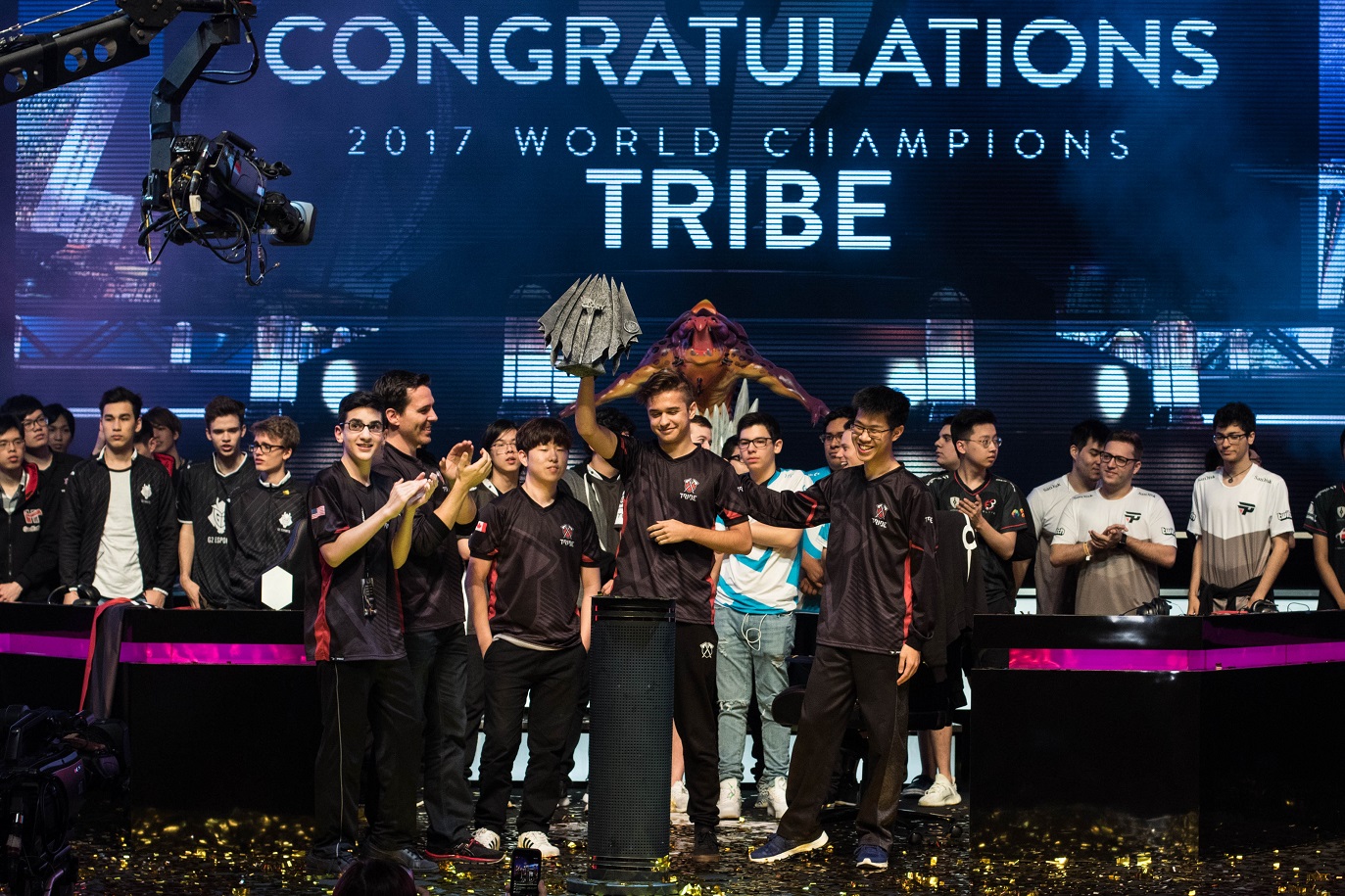I’m sure we can all agree on one thing: a company called Super Evil Megacorp is exceptionally cool, and the fact that it is a gaming company founded by veterans in the gaming industry just adds to the overall coolness. That it is also the developers behind the category defining mobile MOBA, Vainglory, just adds to this company’s appeal.
At the Razer 2017 Vainglory World Championships in Singapore last month, I spoke to the CEO of Super Evil Megacorp, Kristian Segerstrale, about the company’s deep gaming roots, the future of Vainglory, and the burgeoning potential of mobile gaming.
Deep Roots
Segerstrale himself comes with a storied past. The highly enthusiastic personality hides a competitive character who has built a number of successful gaming companies in the past. Before investing into Super Evil Megacorp (and then joining the team as CEO), Segerstrale’s past roles include CEO at Playfish, EVP at Electronic Arts, and co-founder of Glu Mobile. He was also a board member at Supercell.
At the heart of Segerstrale’s success is a deep passion for games – both playing and making them. Segerstrale spends about 1.5 hours a day playing Vainglory, as he feels it is important to enjoy the product and learn first-hand any pain points that exists in the game from a gamer’s perspective. Spending this much time on the ground also helps him understand the community better.
A look around the Super Evil Megacorp team reveals a long list of veterans from popular game developers such as Riot Games, Blizzard, Rockstar Games, and more. A demo session of Vainglory’s new 5v5 feature also involved a former League of Legends professional player, who moved to Super Evil Megacorp to consult on game design.
Changing perspectives
Segerstrale’s past works include a number of social-based mini games on Facebook. But Vainglory struck a chord with Segerstrale, who deems himself not as a maker of social games, but rather a maker of games that people care about.
At a time when mobile gaming usually consists of quick, five-minute mini games that lets players weave in and out of as they went about their daily commute, Vainglory was well ahead of its time. As a MOBA, Vainglory forces users to invest a specific amount of time specifically on the game – and dangles tantalising rewards for those who do.

Vainglory taps on the human condition of teaming up for a common objective; while solving puzzles yourself is satisfying, there is a greater buzz when you achieve an objective together. Segerstrale’s idea of the “pinnacle” of a social game is when real-time interactions between players that are complementary, and ultimately necessary in completing an objective. Vainglory, he says, is the perfect example of this: its heroes are like puzzle pieces that complement other heroes. Getting a combo of skills between different heroes just right results in that team wipe that is immensely satisfying; get it wrong, and you get a similar amount of frustration.
It is this dizzying sense of elation and frustration that proved addictive for Vainglory players, and the prime reason why they keep coming back. The game, like other MOBAs, isn’t exactly easy to pick up and master like its desktop counterparts, but somehow, it struck a chord with millions around the world.
An E.V.I.L. soul

Vainglory was designed from the ground up to be a competitive MOBA for the smartphone generation. It was a huge technical challenge to create this level of immersion and precision that the game is today – but Super Evil Megacorp had always wanted this game to be an embodiment of the capabilities of the brilliantly-named E.V.I.L. game engine. This was the reason why Apple invited Super Evil Megacorp to demonstrate Vainglory at the launch of the iPhone 6 way back in 2014.
What began as a hobby project for CTO Tommy Krul eventually became the heart and soul of the company. Segerstrale states that the company spent over a year developing the engine, before the team agreed that it was ready to handle the “unapologetically high” demands of the team – they are all gamers, after all. The goal was lofty: to bring to the touchscreen generation the same level of quality and sense of real-time collaboration and competition designed for the PC gamer – essentially bringing that experience to a smaller screen without diluting it.
From the start, Vainglory’s biggest challenge was in ensuring a high level of accuracy and providing players complete control on a map. Controls, in particular, were the primary focus. The developers agreed early on that slapping on a virtual joystick was not the way to go: players won’t be able to accurately aim or execute complicate combos quickly, resulting in a slower APM (actions per minute) that will ultimately kill the game.

The next challenge was teaching the basics of the game. How do you get gamers who are used to mindless, five-minute games on their smartphones to invest a significantly longer amount of time and attention into Vainglory?
Super Evil Megacorp eventually created a series of tutorials to help beginners, while experienced players created community guides that are published online. But what turned out to be the best method was simply word of mouth, when an experienced player introduces the game to their friends and showing them the way. Two years, millions of active users, and tons of community-sourced guides later, the need for educating is no longer needed.
A benchmark of mobile gaming

While in 2014, Vainglory served as a means to demonstrate the gaming capabilities of the iPhone 6, in 2017 the same game served as a benchmark of mobile gaming’s technical possibilities today. “It wasn’t just (about) making a game, but making a game that makes a statement,” Segerstrale firmly said. Super Evil Megacorp wanted the new Vainglory update to be a statement of how far mobile gaming hardware had come. Vainglory 5v5, Segerstrale claims, “sets a marker in the industry”.
However, Vainglory isn’t the first to introduce 5v5 gaming. In fact, it is rather slow to the picture, with a few of the game’s rivals already implementing it for some time now. But Segerstrale’s reason was simple: until the developers feel the game engine is fully optimised to handle that feature, Vainglory 5v5 will not be released.
For Segerstrale and his team, it wasn’t a matter of adding support for four more players, increasing the amount of lanes, and then calling it a day. The team wanted Vainglory 5v5 to showcase more firsts in mobile gaming – and it can be argued that Super Evil Megacorp may have done just that. With support for over 200 actors and 3 million polygons rendered in each frame, it was the introduction of fog of war that’s technically quite a feat. No mobile game has this feature because of the complex calculations required to implement it – fog of war was simply too computationally expensive.
Again, Segerstrale points to the E.V.I.L. engine’s prowess behind this feature. The team invested heavily into optimising the game to be as efficient as possible, to the point where any device that can already run Vainglory can run Vainglory 5v5 and all its new features. Given that the game is tested to run on an iPhone 4 and Samsung Galaxy S4 (“it won’t run well on these devices, but they will run”), it is safe to say this isn’t a claim that’s too far-fetched.
On top of that, Vainglory’s already smooth 60fps performance now supports 120Hz on devices that have that display. The number of devices is admittedly low (the Razer Phone and iPad Pro are the only devices with this display), but again, it is a technical feat to be able to double the frame rates without affecting the performance of the game whatsoever.
The future of Vainglory
Nevertheless, there is still plenty of room for improvement. Segerstrale says that the number of games similar to Vainglory and having their own levels of success is good for the industry. For one thing, gamer culture is well and truly globally accepted if it is socially acceptable for people to play games on their smartphones for extended periods of time.
On the other hand, Segerstrale is confident that Vainglory will stick around in the years to come. Having competition is good, simply because while the premise is the same, each developer may introduce new features that others may not have thought about – this will eventually improve the entire genre, and make players demand more out of the game.
For Vainglory, Segerstrale says that social integrations may be a feature that will come. Players have requested to be able to share their victories seamlessly on Facebook, for example. Beyond that, Segerstrale says that the team has its ears close to the ground.
Pushing boundaries
The speed at which smartphone hardware is improving is truly exciting for Segerstrale and his team at Super Evil Megacorp. There is so much potential to explore when it comes to gaming on a smaller screen, when the hardware allows it. Features that were previously impossible to implement is now possible, thanks to faster processors.
Vainglory was already a complex game that runs fantastically well on mobile – Vainglory 5v5’s release simply shows that there is a lot more that can be done.
Follow us on Instagram, Facebook, Twitter or Telegram for more updates and breaking news.








